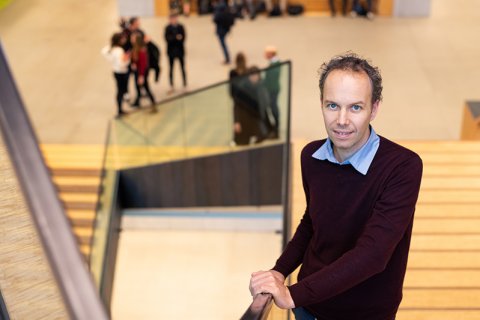Erik van Sebille
Professor in the Department of Physics and Freudenthal Institute

My team and I do research on how ocean currents move plastic around. Lots of people are worried about the plastic in the ocean but the scary thing is we only know where 1% of the ocean plastic is. The other 99% could be anywhere! We won’t really understand the problems that the plastic causes until we know where it is – which is where our simulations come in. One day we hope to be able to create a comprehensive map which shows all the plastic in the oceans.
One day we hope to be able to create a map which shows all the plastic in the oceans.
The researchers in the Faculty of Science are all really open. We’re not afraid to really talk to each other, to ask probing questions. We go beyond institutes and hierarchies to really share knowledge and help each other out. There are no barriers between faculties and departments either. If you want to understand what happens to plastic in the ocean, you have to understand the material – that’s where chemists come in. We work closely with the Biology department to understand what plastic does to marine life. We work with Geosciences and the Faculty of Law.
I love the versatility of my job. I do so many different things in a day and I always feel like a fundamental connection. One hour I’m teaching, the next I’m running my own computer simulations and the next I’m in a meeting with a PhD researcher in my team… without whom I’d never be able to map all the plastic in the ocean.
In my lectures I feel a huge responsibility to help students to understand why the ocean is so important. And why we need to study the ocean. The ocean is wild, dangerous and misunderstood. Did you know that the maps we have of the surface of Mars are twenty times better than the maps of our own oceans? We have to start understanding the ocean if we want a brighter, more sustainable future.
I do so many different things in a day and I always feel like a fundamental connection.
Luckily, inspiring students at Utrecht is easy because they get such varied input. We spend a lot of time discussing the intricacies of the ocean. We work on our animations and computer simulations. And, most importantly, we do field work. The only way to really understand how important the work we do is to get out into the middle of the ocean and appreciate its enormity. Students at Utrecht get that opportunity.
The best thing about working in this faculty is that the distance between me and the students is so short. They call me by my first name, we chat in the hallways, we work and study in the same areas. This all adds up to create a really open atmosphere.
The best thing about working in this faculty is that the distance between me and the students is so short.
This spirit of collaboration extends beyond the university as well. The nice thing about the Netherlands is that it’s a small country, and Utrecht is very central. It’s easy to take the train to other universities to discuss things and pool resources. And, of course, I travel internationally when needed. Research is a social, collaborative task.
Thanks to all of these fundamental connections, we recently started measuring the smallest particles of plastic in the ocean. No-one else in the world can measure these particles yet. But our interdisciplinary team at Utrecht University can …

